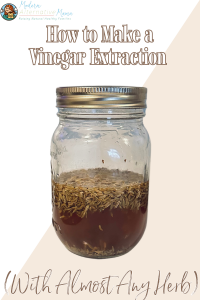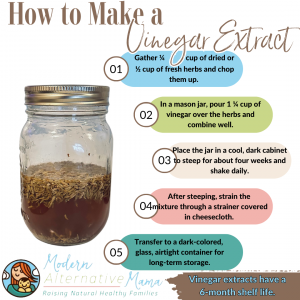By Sarena-Rae Santos, Natural Health Blogger
As fun as medicine making is, it is not the only option when making herbal remedies. One of my favorite things is functional foods. Functional foods are highly nutritious and brimming with health benefits. One of the easiest ways to incorporate functional foods is vinegar extracts.
In high school, I was diagnosed with gastritis, and in my early adult years, I was diagnosed with gastroesophageal reflux disease (GERD). I have managed these issues naturally since 2019, but I wanted to take it a step further with functional foods.
When I was ready to dab with vinegar extractions, I stuck to a single herb to not overcomplicate the process. I chose an herb with digestive-supporting properties. My first vinegar extraction was a Fennel-Infused Apple Cider Vinegar, which went well.
Now for the moment you’ve been waiting for – how to make a vinegar extraction.
How to Make a Vinegar Extraction
If you read our blog, How to Make an Herbal Extraction (With Any Herb), you know vinegar extractions (or vinegar infusions) aren’t as popular for a few reasons, one being that they’re a bit different than all the other extraction methods mentioned. Unlike the other extraction methods mentioned, vinegar infusions extract minerals instead of herbal constituents. The extraction process of acidic vinegar makes them less ideal for medicinal purposes and more ideal for functional foods.
Vinegar extractions are very similar to alcohol extractions and are made by soaking fresh or dried herbs in vinegar for a certain timeframe (usually about four weeks). Vinegar extractions, like alcohol, should follow the 1:5 ratio. Some herbalists use a 1:3 or 1:4 ratio for harder herbs like roots. Unlike an alcohol extraction with a two-year shelf life, vinegar extractions have a six-month shelf life.
Let’s discuss step-by-step how to make a vinegar extraction, but first, let’s go over basic supply recommendations.
Recommended Supplies:
- Mason jar
- Herbs of choice (I use Starwest Botanicals or Frontier Co-Op)
- Vinegar (I use organic apple cider vinegar)
Step 1: Gather ¼ cup of dried or ½ cup of fresh herbs and chop them up.
Step 2: In a Mason jar, pour 1 ¼ cup of vinegar over the herbs and combine well.
Step 3: Place the jar in a cool, dark cabinet to steep for about four weeks and shake daily.
Step 4: After steeping, strain the mixture through a strainer covered in cheesecloth.
Optional: Some people use a French press to extract the remaining liquid after straining the mixture.
Step 5: Transfer to a dark-colored, glass, airtight container for long-term storage.
Storage: It will last about six months when stored in a cool, dark place like a cabinet (you can also store in the refrigerator to retain flavor). If you notice a rancid smell or visible mold at the top, it has gone bad.
Vinegar extractions aren’t as popular for a few reasons. Firstly, vinegar isn’t a great solvent for most herbal constituents. Secondly, some people find vinegar’s taste overwhelming, making it harder to take. These two reasons and a shorter shelf life make many prefer alcohol or glycerin extractions.
Whether you’re a newbie or a seasoned herbalist, I hope this post was able to answer questions you may have had. Remember, herbalism isn’t all or nothing; every herbalist doesn’t look the same. It is okay to start slow, at your own speed, and figure out what works for you. Trial and error is the key, but hopefully, this post takes away most of the errors and leaves you with plenty of successful herbal remedies. Either way, with practice (and time), you’ll be making herbal remedies for everyone in your life in no time.



